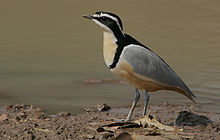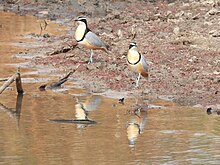Egyptian plover
| Egyptian plover | |
|---|---|

| |
| Kaur Wetlands, the Gambia | |
| Scientific classification | |
| Domain: | Eukaryota |
| Kingdom: | Animalia |
| Phylum: | Chordata |
| Class: | Aves |
| Order: | Charadriiformes |
| Family: | Pluvianidae Reichenbach, 1848 |
| Genus: | Pluvianus Vieillot, 1816 |
| Species: | P. aegyptius
|
| Binomial name | |
| Pluvianus aegyptius | |

| |
| Range | |
| Synonyms | |
|
Charadrius aegyptius Linnaeus, 1758 | |

The Egyptian plover (Pluvianus aegyptius), also known as the crocodile bird, is a wader, the only member of the genus Pluvianus. It occurs in a band across Sub-Saharan Africa from Senegal in the west to Ethiopia in the east and south to parts of the Democratic Republic of the Congo. It no longer occurs in Egypt. The species was formerly placed with the pratincoles and coursers in the family, Glareolidae, but is now regarded as the sole member of its own monotypic family Pluvianidae.
The species is one of several plovers doubtfully associated with the "trochilus" bird mentioned by the Greek historian Herodotus in a supposed cleaning symbiosis with the Nile crocodile.
Taxonomy
[edit]The Egyptian plover was formally described in 1758 by the Swedish naturalist Carl Linnaeus in the tenth edition of his Systema Naturae. He placed it in the genus Charadrius and coined the binomial name Charadrius aegyptius.[2][3] Linnaeus based his account on the description by the Swedish naturalist Fredrik Hasselqvist that had been published in 1757.[4] The Egyptian plover is now the only species placed in the genus Pluvianus that was introduced in 1816 by the French ornithologist Louis Vieillot.[5][6] The species was formerly placed with the pratincoles and coursers in the family Glareolidae but beginning in 2007 molecular phylogenetic studies showed that it is not closely related to these species.[7][8] It was therefore moved to its own family Pluvianidae that had been proposed (as Pluvianinae) in 1848 by the German naturalist Ludwig Reichenbach.[6][9] The genus name Pluvianus is from the French pluvier meaning plover. This was based on the assumed close relationship with the plovers in the family Charadriidae.[10] Edme-Louis Daubenton used the French name, "Pluvian du Sénégal"' for the species in his Planches Enluminées D'Histoire Naturelle that was published between 1765 and 1783.[11] The species is considered to be monotypic: no subspecies are recognised.[6]
Description
[edit]The Egyptian plover is a striking and unmistakable species. The 19–21 cm (7.5–8.3 in) long adult has a black crown, back, eye-mask and breast band. The rest of the head is white. The remaining upperpart plumage is blue-grey, and the underparts are buff. The longish legs are blue-grey. The sexes are similar but juveniles are duller and the black marking are intermixed with brown. There is no seasonal variation.[12]
In flight the black crown and back contrast with the grey of the upperparts and wings. The flight feathers are brilliant white crossed by a black bar. From below, the flying bird is entirely white, apart from the buff belly and black wing bar. The end of the tail has a white band. After landing, members of a pair greet each other by raising their wings in an elaborate ceremony that shows off the black and white markings.[12]
The most frequent vocalisation is a high-pitched krrr-krrr-krrr.[12]
Distribution and habitat
[edit]The Egyptian plover is a localised resident in tropical Sub-Saharan Africa from Senegal in the west to Ethiopia in the east and south to parts of the Democratic Republic of the Congo. It breeds on sandbars in large rivers and avoids forested areas.[13] Despite its vernacular and scientific names, it is not present in modern-day Egypt.[12][13]
Behaviour and ecology
[edit]This is relatively tame bird that is found in pairs or small groups near water.[12]
Breeding
[edit]Breeding takes place between early January and the end of March. The nest is a scrape in loose sand on a riverine island. The clutch is usually 3 to 4 eggs which are light yellow-brown with red-brown to grey spots and measure around 32 mm × 24 mm (1.26 in × 0.94 in). The eggs are incubated by both sexes and hatch after 28–31 days. The parent covers the eggs with sand when it leaves the nest. During the hot period of the day the parents wet the feathers of their underparts and then use this water to soak the eggs and the associated covering layer of sand. The chicks are precocial and nidifugous. They are cared for by both parents and can feed themselves independently when around 1 week of age. The fledging period is around 35 days.[12]
Food and feeding
[edit]The Egyptian plover mainly eats invertebrates such as worms, molluscs, aquatic insects and small flies. It picks food from the surface as well as probing with its bill in damp sand. Insects are sometimes caught in the air.[12]
Supposed relationship with crocodiles
[edit]The bird is sometimes referred to as the "crocodile bird" based on the belief that the species had a symbiotic relationship with crocodiles.[13] According to Herodotus, the crocodiles lie on the shore with their mouths open and a bird called "Trochilus" flies into the crocodiles' mouths so as to feed on decaying meat lodged between the crocodiles' teeth.[14] The identification of the Trochilus with any particular plover is doubtful and the cleaning symbiosis itself has never been documented by video or photographic evidence.[15][a][b][18]
Gallery
[edit]Notes
[edit]- ^ The image by Warren Photographic showing an Egyptian plover apparently inside the mouth of a Nile crocodile is stated on its website to be "[a] digital reconstruction of [the] popular myth attributed to Herodotus, 5th Century BC. Africa."[16]
- ^ The short video showing seven Egyptian plovers cleaning the mouth of a crocodile is CGI from a bubble gum advertisement[17]
References
[edit]- ^ BirdLife International (2016). "Pluvianus aegyptius". IUCN Red List of Threatened Species. 2016: e.T22694086A93437931. doi:10.2305/IUCN.UK.2016-3.RLTS.T22694086A93437931.en. Retrieved 11 November 2021.
- ^ Linnaeus, Carl (1758). Systema Naturae per regna tria naturae, secundum classes, ordines, genera, species, cum characteribus, differentiis, synonymis, locis (in Latin). Vol. 1 (10th ed.). Holmiae (Stockholm): Laurentii Salvii. p. 150.
- ^ Peters, James Lee, ed. (1934). Check-List of Birds of the World. Vol. 2. Cambridge, Massachusetts: Harvard University Press. p. 298.
- ^ Hasselquist, Fredrik (1757). Iter Palæstinum, eller Resa til Heliga Landet, förrättad ifrån år 1749 til 1752 : med beskrifnigar, rön, anmärkingar, öfver de märkvärdigaste naturalier, på Hennes Kongl. Maj.ts befallning (in Swedish and Latin). Stockholm: Trykt på L. Salvii kåstnad. pp. 256–257, No. 31.
- ^ Vieillot, Louis Pierre (1816). Analyse d'une Nouvelle Ornithologie Élémentaire (in French). Paris: Deterville/self. p. 55.
- ^ a b c Gill, Frank; Donsker, David; Rasmussen, Pamela, eds. (December 2023). "Buttonquail, thick-knees, sheathbills, plovers, oystercatchers, stilts, painted-snipes, jacanas, Plains-wanderer, seedsnipes". IOC World Bird List Version 14.1. International Ornithologists' Union. Retrieved 14 August 2024.
- ^ Baker, A.J.; Pereira, S.L.; Paton, T.A. (2007). "Phylogenetic relationships and divergence times of Charadriiformes genera: multigene evidence for the Cretaceous origin of at least 14 clades of shorebirds". Biology Letters. 3 (2): 205–210. doi:10.1098/rsbl.2006.0606. PMC 2375939. PMID 17284401.
- ^ Kuhl, H.; Frankl-Vilches, C.; Bakker, A.; Mayr, G.; Nikolaus, G.; Boerno, S.T.; Klages, S.; Timmermann, B.; Gahr, M. (2021). "An unbiased molecular approach using 3′-UTRs resolves the avian family-level tree of life". Molecular Biology and Evolution. 38 (1): 108–127. doi:10.1093/molbev/msaa191. hdl:21.11116/0000-0007-B72A-C. PMC 7783168. PMID 32781465.
- ^ Reichenbach, Ludwig (1848). Synopsis avium. Ornithologie méthodique, concernant les genres et les espèces des oiseaux de toutes les parties du monde. Nr. III. Gallinaceae (in French). Dresden und Leipzig: Asher und Co., A., Hofmeister, F. p. [6] (pages unnumbered).
- ^ Jobling, James A. (2010). The Helm Dictionary of Scientific Bird Names. London: Christopher Helm. p. 311. ISBN 978-1-4081-2501-4.
- ^ Buffon, Georges-Louis Leclerc de; Martinet, François-Nicolas; Daubenton, Edme-Louis; Daubenton, Louis-Jean-Marie (1765–1783). "Le pluvian de Senégal". Planches Enluminées D'Histoire Naturelle. Vol. 10. Paris: De L'Imprimerie Royale. Plate 918.
- ^ a b c d e f g Cramp, Stanley, ed. (1983). "Pluvianus aegyptius Egyptian Plover". Handbook of the Birds of Europe the Middle East and North Africa. The Birds of the Western Palearctic. Vol. III: Waders to Gulls. Oxford: Oxford University Press. pp. 85–91. ISBN 978-0-19-857506-1.
- ^ a b c Maclean, G.L. (1996). "Family Glareolidae (Coursers and Pratincoles)". In del Hoyo, J.; Elliott, A.; Sargatal, J. (eds.). Handbook of the Birds of the World. Vol. 3: Hoatzin to Auks. Barcelona, Spain: Lynx Edicions. pp. 364–383 [377]. ISBN 978-84-87334-20-7.
- ^ Herodotus (1858). The History of Herodotus. Vol. 2. Translated by Rawlinson, George. London: John Murray. p. 116.
- ^ Crocodiles Would Never Eat This Bird, January 2022, retrieved 2023-02-03
- ^ "WP00955 Nile Crocodile (Crocodylus niloticus) with Egyptian Plover or Crocodile Bird (Pluvianus aegyptius)". Warren Photographic. Retrieved 25 February 2015.
WP00955 Nile Crocodile (Crocodylus niloticus) with Egyptian Plover or Crocodile Bird (Pluvianus aegyptius) - digital reconstruction of popular myth attributed to Herodotus, 5th Century BC. Africa.
- ^ "Dentyne White - Crocodile bird". YouTube. 14 December 2007. Retrieved 19 July 2019.
- ^ Howell, Thomas R. (1979). Breeding Biology of the Egyptian Plover Pluvianus aegyptius. University of California Publications in Zoology: 113. Berkley, California: University of California Press. pp. 4–5. ISBN 978-0-520-03804-2.






